All Articles
Contents
The Most Successful Intelligence Operation in History - March 9, 2025
Article Series: Achieving Progressive Goals with Root Cause Analysis - February 17, 2024
Preventing the Death of Democracy - January 1, 2024
A Poem of Hope for the Survival of Democracy - January 6, 2023
Why are conservatives more likely to attack fact-checking? - August 25, 2017
The Power of Deception Just Won - November 11, 2016
Digging Down to the Root Cause of the Trump Phenomenon - November 3, 2016
The WorldChange Model - December 2013
No Solutions to Problems Like These - June 2012
Successive Generations of Environmental Solutions - February 2012
A Little Story about Corporate Dominance and the Occupy Movement - December 2011
The Dualistic Nature of the Sustainability Problem - November 2011
New Tools for Smart CSOs - October 2011
A Story of Two Processes - September 2009
The IPAT Equation - December 2008
The Powell Memo - October 2006
Breaking the Thirty Year Deadlock: The Three Essays - August 2006
Learning from Past Societies - September 2006
A Model in Crisis: A Soaring Overview - April 2006
The Memetic Evolution of Solutions to Difficult Problems - April 2006
Memetics at Thwink.org - August 2006
Critique of the Harvard Project - February 2006
How the Environmental Movement Can Find Its Way Again - August 2005
Reading Notes for Jared Diamond's Collapse - June 2005
Criteria for Evaluating a Book of Nonfiction - June 2005
Inching Towards Truth Ratings - October 2004
Introduction to Strategy Maps - May 2004
That Elusive Management Spark - May 2004
What Have We Learned Here? - May 2004
What Is an Analytical Approach? - April 2004
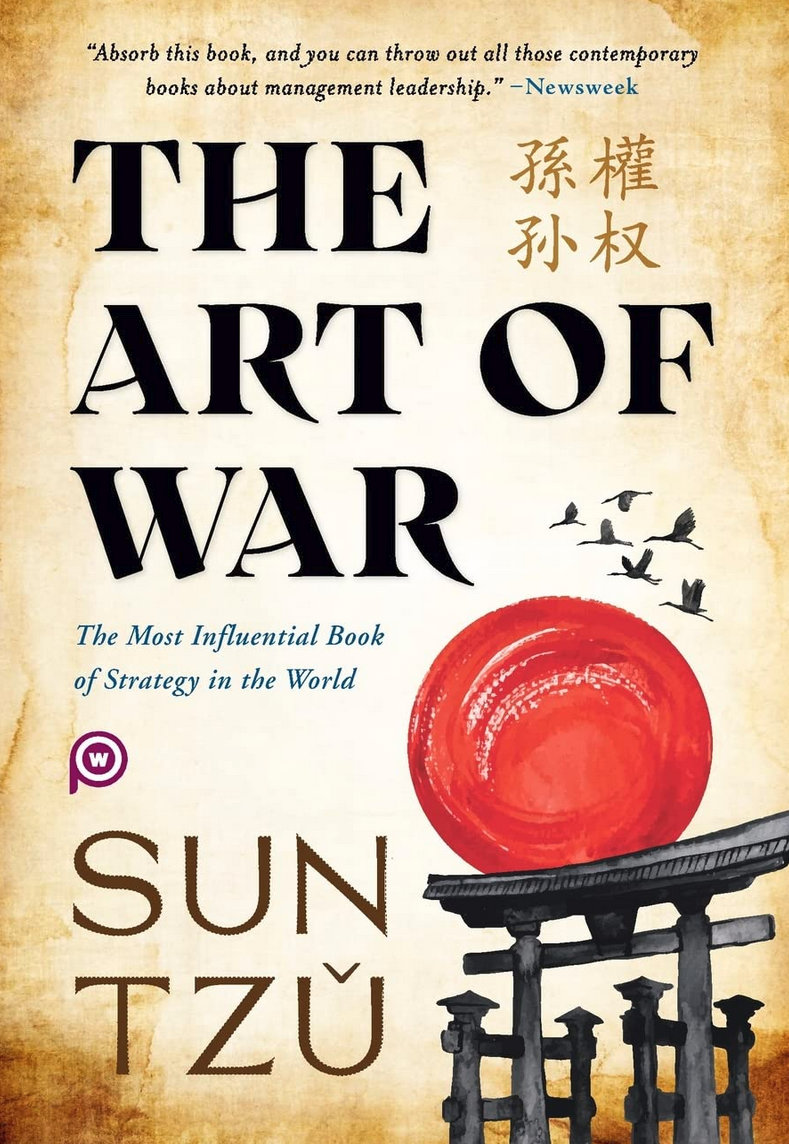
The Most Successful Intelligence Operation in History
How Russia Put a Spy at the Top of the World’s Sole Superpower and Is Proceeding to Destroy It and Democracy
This describes how Russia put a spy (Donald Trump) at the top of the world's sole superpower (the United States) and is proceeding to destroy it and democracy. The intent of the article is to wakeup non-Trump supporters and mainstream media to the fact a Russian agent and other agents now control the United States.
The article is on Substack. This is where future articles will be for a while.
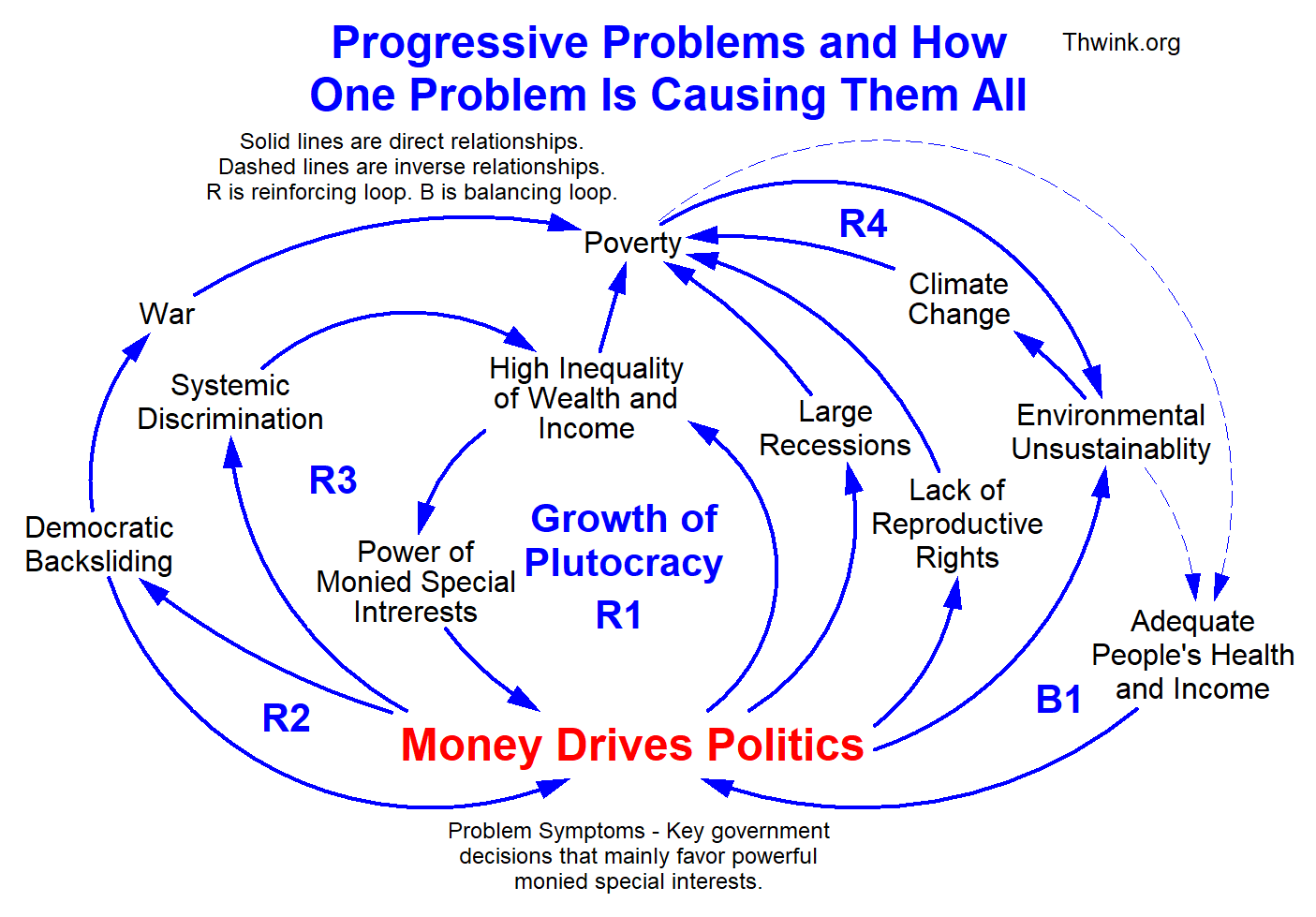
Article Series: Achieving Progressive Goals with Root Cause Analysis
From January 15 to February 17, 2024 Thwink published a series of 6 articles on Daily Kos, the largest progressive news and blog site in they US. The articles apply the Thwink tools, notably social force diagrams, to the problem of how to achive progressive goals. The diagram is from article 4.

Preventing the Death of Democracy: First a correct diagnosis, then the cure will work
A global epidemic of deadly backsliding from democracy to authoritarianism is underway, with no solution in sight. Why is this? Because of an incorrect diagnosis of the cause of the problem. The article shows how a correct diagnosis can be achieved with root cause analysis. Once the diagnosis is correct, solutions that will work can be designed, tested, and applied.
The article makes a key observation: "Reliably and efficiently solving difficult complex causal problems to a high level of quality requires formal, prolonged application of an appropriate form of root cause analysis. No other method is known."

A Poem of Hope for the Survival of Democracy
The most important problem of our time is the backsliding of democracy to authoritarinism. If this problem is not solved, humanity will find it impossible to solve many large-scale problems, including climate change and war. This is because authoritarians care only about themselves and the group allowing them to stay in power, which excludes common good problems.
The poem deals with the plight of Ukraine, now fighting for its life against Russia. If Ukraine loses, then democracy is doomed.
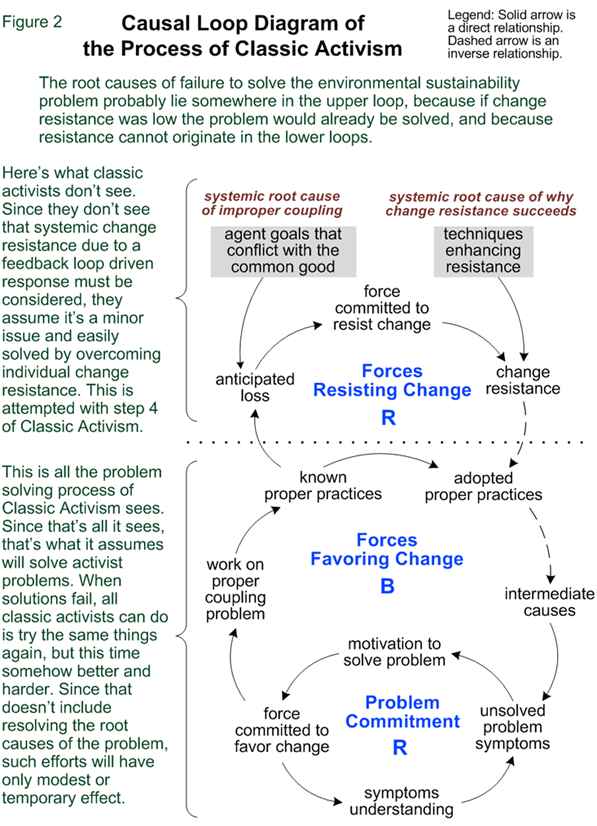
Why are conservatives more likely to attack fact-checking?
It's a fact. An article shows how "Conservative websites are far more likely to attack fact-checkers than their liberal counterparts."
But the article only delves into the fact (pun intended) this is happening. But WHY? What are the analytical reasons behind this behavior? That's what our own article attempts to explain.

The Power of Deception Just Won
People are in shock. A lot are asking a question they thought they would never ask: What just really happened? And what can we do about it? Using root cause analysis, this article explains why Trump won and what can be done about it.
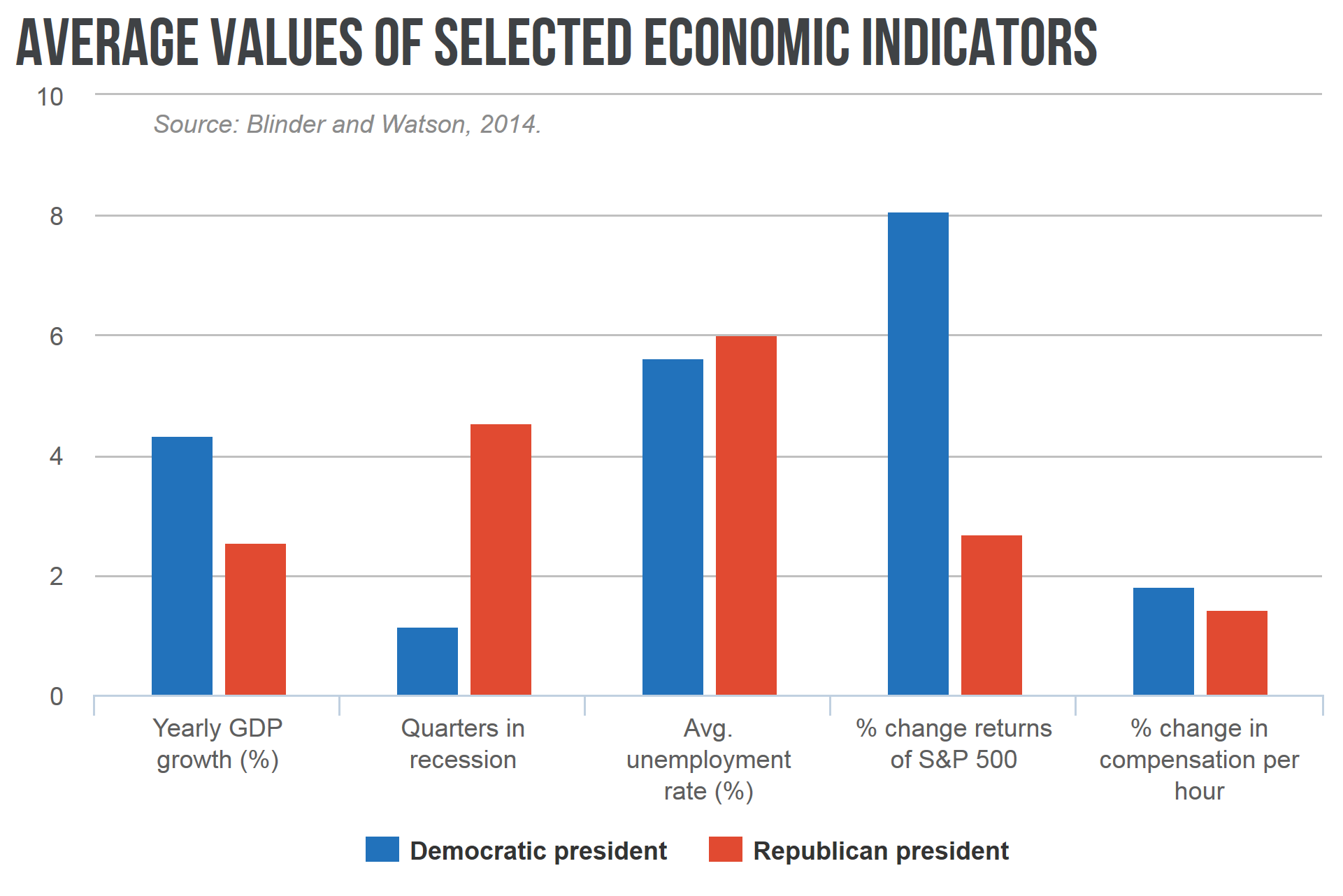
Digging Down to the Root Cause of the Trump Phenomenon
Why is Donald Trump a serious contender for winning the 2016 United States presidential election, when to the fact-based observer his policies and temperament would be ruinous to the United States and the world? This in depth article presents a rigorous analysis of the Trump phenomenon.

At the suggestion of Graham Turner, we have added a change resistance subsystem to the World3 model of Limits to Growth. The result is the WorldChange model. Be sure to watch the Introduction to the WorldChange model video, as this brings alive the potential of the model.

No Solutions to Problems Like These
It's a grim situation. We're making some progress, but on the whole the world's problems are getting worse. We've entered a pre-catastrophe stage. Those with their eyes open can see, quite clearly, that the human system is locked into unsustainable environmental, economic, and social behavior. Grossly unsolved problems like climate change, the recurring wars problem, the recurring large recessions problem, rising income inequality, and more loom large. We have no solutions to problems like these.
So what can we do?

Successive Generations of Environmental Solutions
What's the biggest pattern in the history of environmentalism? This short article proposes the answer is the five successive generations of solutions that environmentalists have tried. Each new generation was expected to work. When it failed, another generation of solutions was tried. They have all failed.
Why is this?
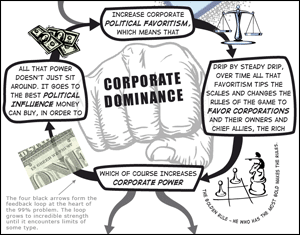
A Little Story about Corporate Dominance and the Occupy Movement
Why not apply root cause analysis to the ultimate problem of our time? The Corporate Dominance Problem is the problem behind other problems, like environmental unsustainability, excessive income inequality, avoidable recessions, and unnecessary wars. Why is the Corporate Dominance Problem so bad? What's its root cause? How can the root cause be resolved? What solutions won't work and why? What solution might work? Find out in this lavishly illustrated article.
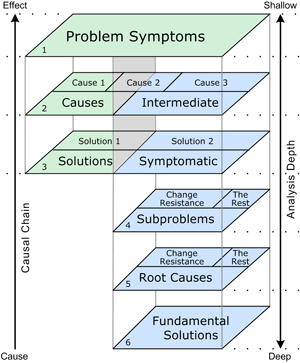
The Dualistic Nature of the Sustainability Problem PDF
The essence of the Thwink paradigm has been summarized into one page. A single diagram is used, as shown.
The idea is that difficult social problems have an inherently dualistic nature: the obvious side of the problem and the hidden side. Traditional viewpoints like Classic Activism see only the obvious side, which is the green portion of the upper layers. An analytical viewpoint is required to see the rest of the layers, all the way down to the root causes and their fundamental solutions.
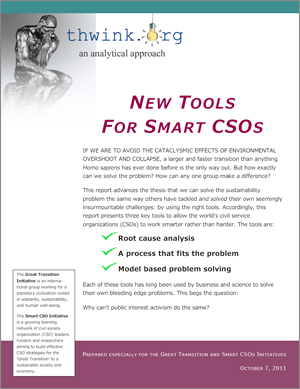
This 14 page report was prepared especially for the Great Transition and Smart CSOs Initiatives. It's message, however, is generic. It applies to all Civil Service Organizations (CSOs), also known as NGOs. The cover says it all:
This report advances the thesis that we can solve the sustainability problem the same way others have tackled and solved their own seemingly insurmountable challenges: by using the right tools. Accordingly, this report presents three key tools to allow the world’s civil service organizations (CSOs) to work smarter rather than harder.
The three tools are the same three tools driving all the work at Thwink.org. The report is thus a comprehensive overview of how the Thwink approach can be applied by Smart CSOs.

This PowerPoint presentation was given on September 9, 2009 to a group of researchers. It frames the Thwink approach as a story about two processes, Classic Activism and the System Improvement Process. Full text notes are included so you can pretend you were there.
The slide shown is the last one. Click on it to see it full size.

If you want to understand what's causing the environmental sustainability problem, this is the place to start.
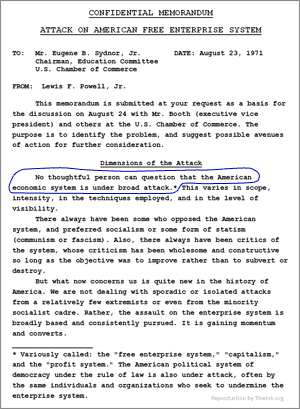
This is the most eye popping short read (7 pages) on the site, if you haven't heard about it.
The Powell Memo was written in 1971. It outlined a plan for corporations to take over the United States political system. The memo opened with the fallacious but highly effective appeal shown on the left. Note the key statement that framed the entire memo:
No thoughtful person can question that the American economic system is under attack.
This is The Big Lie Gambit. If the reader swallows it they are hooked.
"The American economic system" was not under attack. In truth it was "the American economic system" that was attacking The People and the common good. Once the reader swallows this first fallacy, the rest of the memo works. It's infective. So much so that The Powell Memo master plan worked. In twenty some years large for-profit corporations had taken over the entire American system.

Breaking the Thirty Year Deadlock: The Three Essays
"... in 1972 the global environmental sustainability problem was conclusively identified by the international bestseller The Limits to Growth. This was clearly a problem that required immediate action now to avoid catastrophe later. But yet today, over thirty years later, the problem remains unsolved. Why, despite countless attempts by millions of environmentalists, have we been unable to overcome the mountain of change resistance to solving the problem?
"In systems thinking terms, the system is deadlocked. It is fiercely resisting change. No matter how hard environmentalists try to solve the sustainability problem, the system pushes back just as hard, and even harder...."
Here are the essays that explore how to break the deadlock:
Introduction
1. Why Have We Been Unable to Solve the Problem?
2. The Return of the Virtuous Politician
3. An Irresistable Sustainable Business Model

This reviews and compares two books: Treading Lightly by Sveiby and Skuthorpe, and Collapse: How Societies Choose to Fail or Succeed, by Jared Diamond. The latter is highly acclaimed, so one would expect a glowing review. But that's not what the paper finds. Instead, here's the verdict:
The premise is that there is much to learn from the few successes of past societies that were sustainable, and from the many failures of those that were not.
This paper argues that the premise is sound, but the approach used in executing the premise in these works is not. The approach lacks the full analytical rigor necessary to extract valuable cause and effect insights that are highly applicable to today’s sustainability problem. This paper explores this proposition by assessing the process maturity used in the two books. It concludes that while both books have taken valuable first steps, the chief value of works like these lies in the accumulation of data that can be used in future analyses, ones that are more analytical than intuitive.

A Model in Crisis: A Soaring Overview
"As this essay will show... when it comes to the sustainability problem, civilization remains stuck in the Model Crisis step. The longer it stays there the worse the problem will become. Understanding how the Kuhn Cycle works is essential for discovering how civilization can break free of the clutches of the Model Crisis step and move on."

The Memetic Evolution of Solutions to Difficult Problems
How in the world do we successfully analyze impossibly difficult social problems? By simulating how memetic solutions to difficult problems evolve, this 15 page section from the Analytical Activism book shows how memetics can open the door to a penetrating analysis.
Another article demonstrating the same thing is The Dueling Loops of the Political Powerplace. This describes a model that uses true and false memes and memetic infectivity to analyze the sustainability problem.

A meme is a mental belief or behavior learned from others. Social systems are composed of people. People's behavior is determined by the genes they're born with plus the memes they learn later. Judging by how long it takes a child to learn adult behavior, memes determine most human behavior. Therefore when solving difficult social problems the analysis model must revolve around memes.
Memetics is the study and application of the abstraction of memes. This article describes how the poweful tool of memetics has been applied in the work at Thwink.org.

Critique of the Harvard Project PDF
"The Harvard Project" was the nickname for the work described in the 96 page National Purpose, Local Action report prepared by researchers for the Sierra Club. 3 out of 5 were from Harvard. Included was Marshall Ganz, the well known political scientist and activist who went on to play a fundamental role in Barack Obama's 2008 election campaign.
The critique shows that many assumptions in the report are unfounded, naive, and overly optimistic. The report basically promotes making grassroots activism work better in order to solve the Sierra Club's problems. However, so called grassroot activism is another name for Classic Activism. The critique explains why this is incapable of success, even if improved per report recommendations.
Sadly, the critique and hundreds of hours of working with the club had no effect. Even a 45 minute phone call with the President at the time led to nothing, even though during the call she agreed that "The club is a classic activist organization."
Perhaps, though, we've planted seeds that will grow.
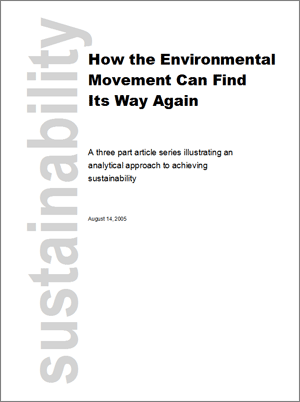
How the Environmental Movement Can Find Its Way Again PDF
As part of working with the Sierra Club, the Greater Gwinnett County Group of Georgia created and mailed out copies of this article to to 60 some chapters, 30 some field offices, all 15 board members, and all 7 members of the executive group. Here is the cover letter PDF for the mailing. Much discussion followed.
This 37 page article is packed with analysis and careful argument. It contains these three parts:
Part One - Why the Environmental Movement Needs the Right Process
Part Two -
Why Environmentalists Are Facing Such Hostile Opposition
Part Three -
How to Raise General Ability to Detect Political Deception
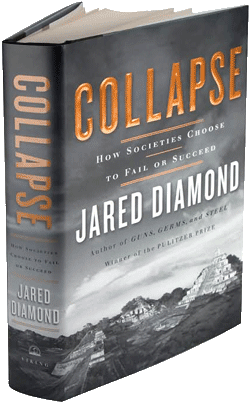
Reading Notes for Jared Diamond's Collapse PDF
Diamond's driving question is “What caused some of the great civilizations of the past to collapse into ruin, and what can we learn from their fates?”
Diamond uses the comparative method to answer the question. But he comes up short because the comparative method is inadequate. It doesn't think in terms of root causes or detailed models of system behavior. It only examines inputs and outputs. This forces Diamond toward provacative but shallow answer like "Question 5. Why did the competive spiral occur? Answer: Because leaders compete for power by seeing who can build the biggest statues."
The Reading Notes show how it's possible to go deeper by asking WHY questions until one arrives at the root causes. For example:
"Question 6: Why does that have relevance to today’s sustainability problem?
Answer: Because a politician is the same as a clan chief."

Criteria for Evaluating a Book of Nonfiction: With Examples from the Field of Environmentalism
This and the above article were for an Atlanta environmental book club. This article discusses these penetration questions:
1. Does the book have a clear, organized argument?
2. Does the book speak to you?
3. Is the argument an emotional or a logical one?
4. Can the book pass the two lookup tests?
5. Does the book prove its central argument is true?
6. Does the book get to the bottom of its subject?
7. Does the book follow the 80/20 rule?

The press, voters, and the law are spontaneously inching towards Truth Ratings. For example When Howard Kurtz wrote in The Fairness Doctrine that "ABC's political director wrote a now-leaked memo saying there is no need for artificial balance in truth-squadding the claims and charges of the Bush and Kerry campaigns," what he was really saying is there needs to be an objective measure of the truth in those claims and charges.
That objective measure is Truth Ratings.
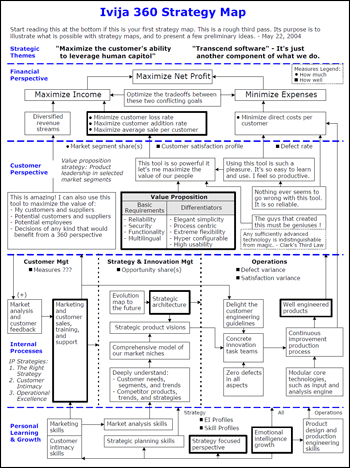
Suppose you are managing a business and have a tough mission to achieve. What's the best overall reasonably simple method to develop and implement a winning strategy?
Until Kaplan & Norton introduced Strategy Maps in the 1990s, there was no good anwer short of getting an MBA, followed by years of mentoring and experience. A Strategy Map is a standard framework for developing a complex business strategy that has a good chance of working, because it addresses the four layers shown on the left, because it's simple enough for everyone to understand, and most of all because it's a process flow diagram. Strategy Maps are a form of process engineering.
This article introduces these concepts with a variety of illustrations.

The article opens with this thought:
There is a certain intangible, invisible, elusive "spark" that is the essence of management. If it's not present in an individual or organization, neither can possibly hope to manage anything well. They are forever doomed to incompetence, frustration, and failure. They can only achieve excellence if lady luck comes their way. This forces the probing mind to ask itself a single guiding question:
What is that spark?

What can you learn from encountering a spark that turns into a small out-of-control fire? This article reflects on that question. Near the end 15 "main problem solving principles" are listed. These were automatically applied at the speed of light during the incident. The articles ends with:
So, what did I learn here? That when faced with a problem I immediately go into a certain sort of problem solving mode, where I'm calmly and objectively applying a complex problem solving process. This process and its elements have been accumulated over a lifetime. And they are still evolving, because I'm always learning.

What Is an Analytical Approach?
When it comes to truly difficult problems, ones that have stumped millions of problem solvers for generations, the analytical approach is the only approach that will work.
But what exactly is an "analytical approach?" Most people have no real idea. Thus when faced with a novel difficult problem they are forced to resort to a non-analytical and therefore an instinctual approach. This of course is the reason their solutions fail.
If you don't want to see your solutions fail too, then consider adopting an analytical approach.


























